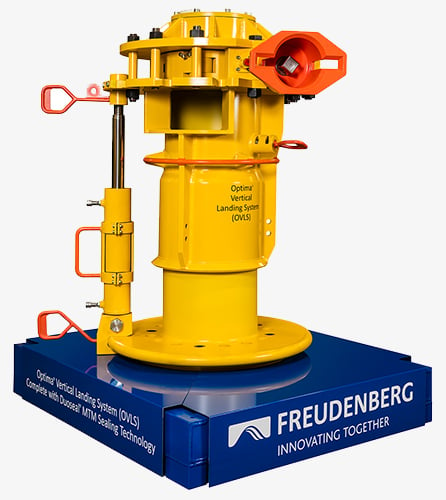Next Upcoming Event
Close
Vertical Tie-in
- Home
- High Integrity connectors
- High Integrity Subsea Connectors
- Vertical Tie-in

Vertical connections are used in many subsea operating systems for jumpers, flow lines and export lines. Typically used in deeper water, these systems allow for easy connection where height is less of an issue (e.g. no snagging of trawler nets). Common locations for these connections are on Xmas Trees, Manifolds, Gas-Lift Modules, PLEM’s & PLET’s and export line connections.
FO> has supplied various vertical tie-in connections, ranging in size from 2” to 24”. These tie-in’s are typically performed using mating funnel arrangements (see image of OVLS). The guidance for the Optima® subsea connector is performed by the two mating funnels, which also incorporates the load transfer from the rigid jumpers & flexibles of applied bending moments and axial loads to the structure below, prior to the Optima® connector being closed. The Optima® connector is fitted within the funnel arrangement, which provides integral structural capacity. The Optima® Vertical Landing System (OVLS) has been designed and tested to incorporate the relevant loadings to suit the largest pipe size for the Optima® connector size.
Each size of the OVLS covers a range of pipe sizes (e.g. OVLS No.08 covers 5”, 6” and 8” NB pipe sizes). The OVLS has been designed to meet the load requirements and also be as compact as possible to minimise the required structure to mount the system on. This has additional benefits in that it reduces the associated cost of the mating structure, which reduces weight and size of the equipment (PLEM, PLET, Tree) and contributes towards a reduction in the size of the vessel needed for installation. These are all factors that help in reducing cost.
FO> supply the full range of tooling to go with the OVLS, including soft landing, jacking, seal-face cleaning and seal removal tools.
Note: The photo also shows the FO> patented Removable Pad Eye Tool fitted to the gooseneck pipe, which allows for adjustment of the position of the main lifting eye with the weight still suspended on the crane downline.